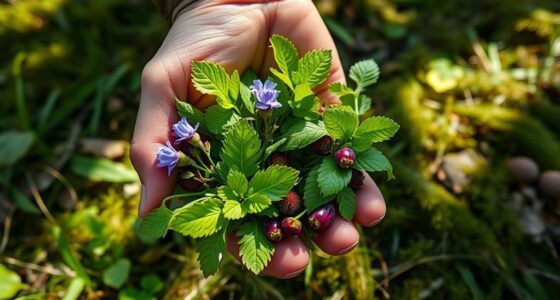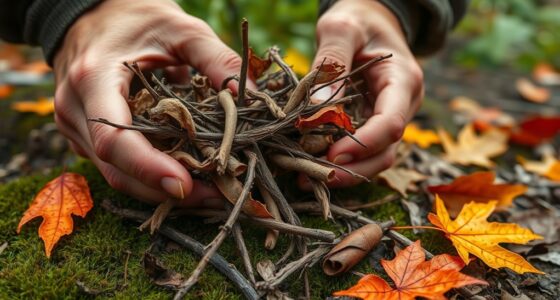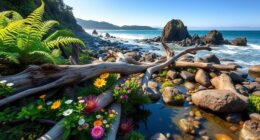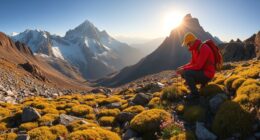To navigate using foraged materials, focus on natural landmarks like mountains, rivers, and large trees to orient yourself. Use the sun’s position, such as the shadow stick method, and find Polaris at night for cardinal directions. Observe vegetation patterns, like moss on the north side of trees, and mark your trail with eco-friendly stones or bent branches. Combining these cues will improve your accuracy and confidence. If you explore further, you’ll discover even more effective natural navigation tricks.
Key Takeaways
- Use natural markers like rocks, bark, or branches to create eco-friendly trail markers and orient yourself along known routes.
- Employ foraged materials such as moss or plant patterns to identify environmental cues and enhance navigation accuracy.
- Collect and interpret natural features like water sources or animal signs to confirm your position and guide movement.
- Incorporate natural landmarks and celestial cues combined with foraged items for reliable, sustainable navigation.
- Minimize environmental impact by marking trails with natural materials and removing markers after use to preserve ecosystems.
Utilizing Natural Landmarks for Orientation
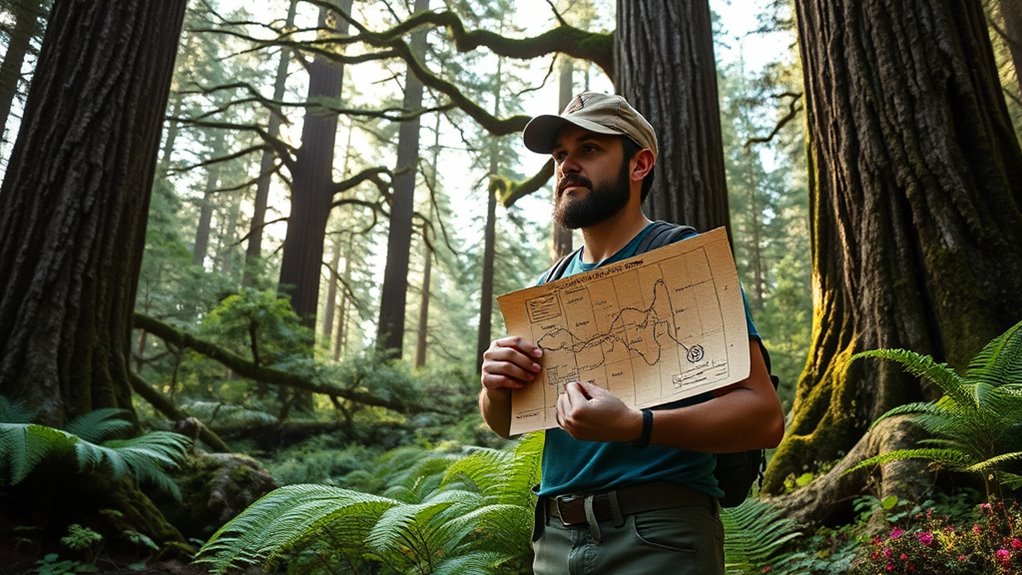
Natural landmarks are essential tools for orientation when traversing through unfamiliar terrain. You can identify prominent features like mountains, hills, rivers, and streams to help you stay on course.
Recognize that mountains and hills serve as visible reference points from afar, guiding your direction. Rivers and streams often flow toward lower elevations and populated areas, so following their flow can lead you to safety or other trails.
Mountains, hills, rivers, and streams are vital landmarks for navigation and orientation.
Unique trees, vegetation, and rock formations act as memorable markers, helping you distinguish your location over time. Use these landmarks to compare with your map, ensuring you stay oriented.
Keep large features in sight to prevent disorientation, and use linear features like rivers as natural “handrails” that guide your movement across the landscape.
Reading the Sun and Stars to Find Direction
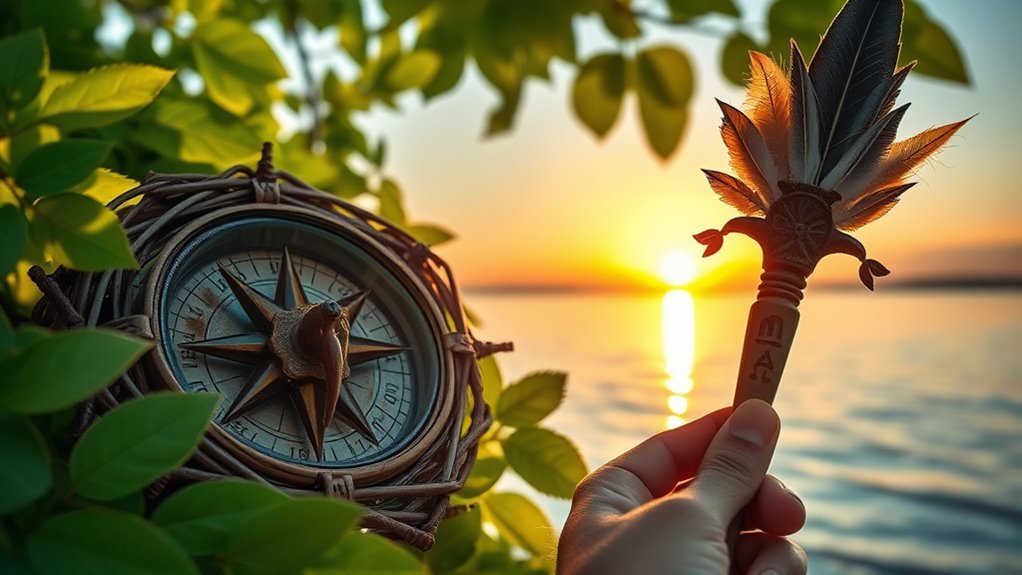
When you need to find your way without a compass or GPS, reading the sun and stars offers reliable methods. During the day, use a shadow stick: push a stick into the ground and mark the tip of its shadow in the morning and late afternoon. At the shortest shadow point, draw a line between the marks; that line runs north-south. The sun’s arc helps determine east and west, as it rises in the east and sets in the west. At noon, observe the sun’s position or measure its altitude with simple tools like a protractor. Interestingly, recent AI discoveries have expanded our understanding of natural phenomena, offering new insights into navigation techniques. Additionally, understanding the contrast ratio of your environment can help you better interpret shadows and light patterns, aiding in daytime orientation. At night, find Polaris—the North Star—using the Big Dipper; it indicates true north. Tracking star movement and using basic tools allows you to navigate even when modern devices are unavailable.
Moss and Vegetation as Guides in Navigation
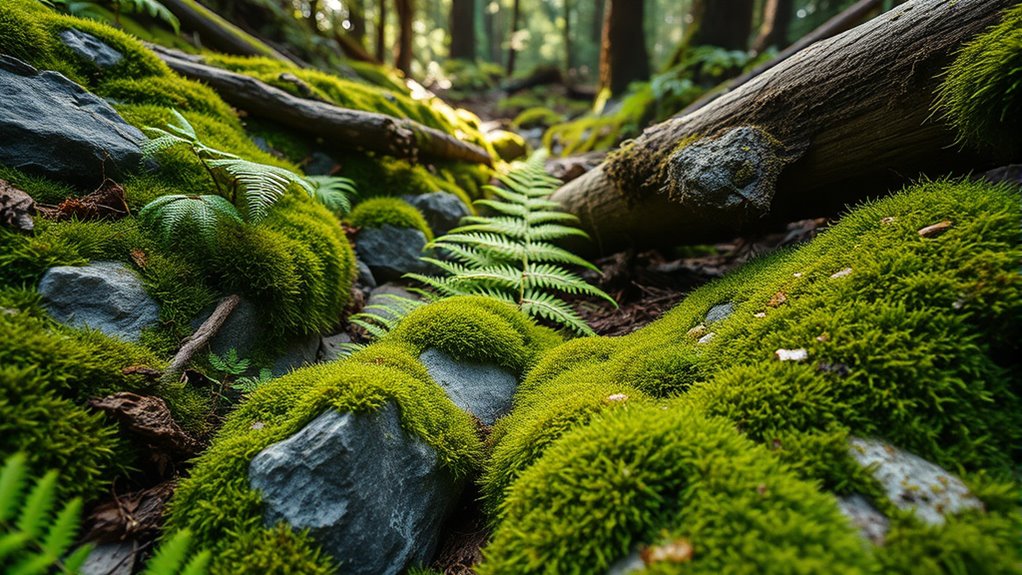
Although moss is often thought to reliably indicate direction, its growth patterns are primarily driven by moisture rather than orientation. It thrives on damp surfaces, especially in shaded areas, making it a poor indicator of compass points. Materials used in planters can influence moisture retention and moss growth patterns. In the Northern Hemisphere, moss tends to grow more on the north side of trees and rocks, but this is due to reduced sunlight and increased moisture, not a true directional cue. Moss below knee height is unreliable because ground moisture varies. Environmental factors like surface texture, slope, and regional climate influence moss growth. To use moss effectively, observe its abundance on shaded, moist surfaces and combine this with other natural indicators for better accuracy. Awareness of environmental influences helps prevent misinterpretation when relying on moss for navigation. Additionally, understanding moss growth patterns can improve the reliability of this natural navigation method. Recognizing natural variability in moss growth is essential for avoiding navigation errors when using this method. Relying solely on moss can lead to errors in navigation.
Trail Marking With Natural Materials
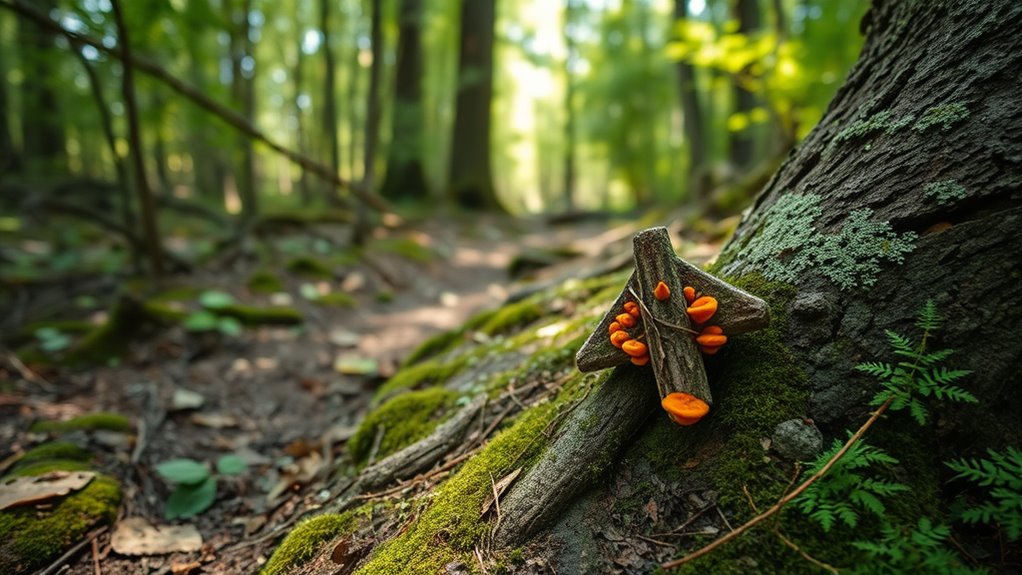
Trail marking with natural materials offers an eco-friendly way to guide hikers without introducing artificial or non-biodegradable elements. You can use stacked rocks, bent branches, or carved symbols on trees to create visible, distinctive markers that blend seamlessly into the environment. Incorporating scenic views into your markers can make them more noticeable and memorable for hikers. These markers leave no trace if removed properly, making them sustainable and cost-effective. To guarantee effectiveness, place markers on prominent features like large rocks or unique trees, creating recognizable patterns that are visible from various angles. Using natural materials also encourages a mindful approach to environmental preservation, which is central to sustainable homesteading practices. Keep in mind that weather and wildlife can alter or erase markers, so maintain consistency and simplicity in your designs. Always remove markers after use to minimize environmental impact. Using natural materials fosters a respectful, harmonious connection with nature while helping fellow hikers stay on the correct path.
Combining Landmarks and Celestial Cues for Accurate Navigation
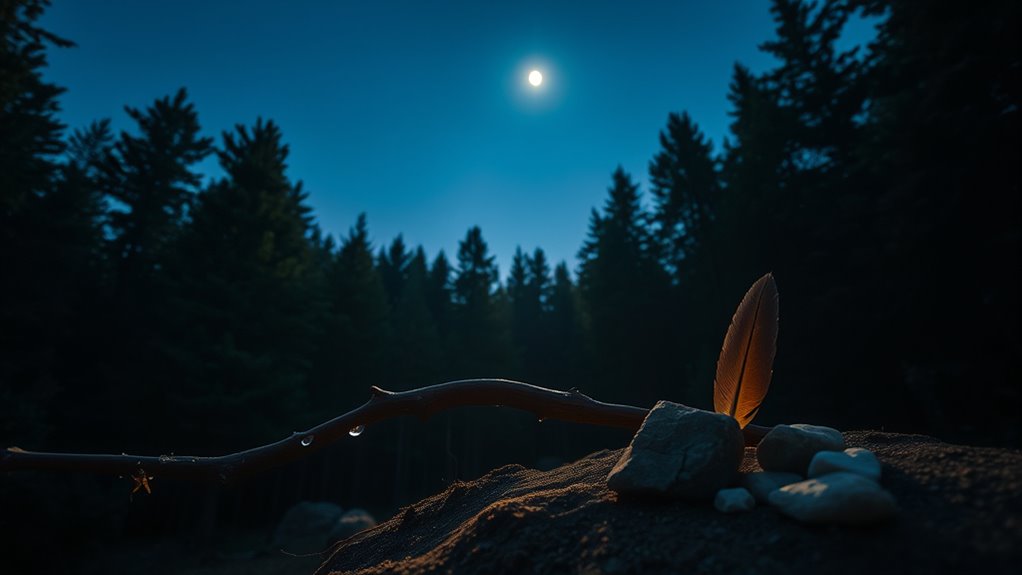
Using natural markers helps you stay on track during hikes, but relying solely on landmarks or celestial cues can limit your navigation accuracy. Combining these methods allows you to leverage both visual references and directional signals for better precision. Acknowledging the importance of dream symbols in understanding subconscious cues can also enhance your interpretative skills in navigation by recognizing underlying patterns and signals. Landmarks, like mountains or trees, help you recognize specific locations and recall routes, especially over short distances. Celestial cues, such as the sun during the day or stars at night, provide reliable directions over long distances. Additionally, understanding cookies and privacy management can improve your awareness of how information and signals are processed, which parallels recognizing environmental cues in navigation. Incorporating data-driven strategies can further refine your ability to interpret environmental signals and improve decision-making during navigation. Recognizing the power consumption of heated mattress pads and their energy efficiency can inspire thoughtful resource management during extended outdoor activities. Being mindful of expiration of vape juice and how storage conditions affect quality can parallel the importance of maintaining accurate environmental cues in navigation. When you combine these cues, your brain can match current views with memories, adjusting based on cue reliability. This flexibility, used by animals and humans alike, improves navigation in diverse environments, reduces dependence on a single method, and boosts your chances of reaching your destination accurately.
Using Coastal and River Features as Navigational Aids

Coastal and river features serve as crucial navigational aids by providing distinctive natural landmarks and environmental cues. Prominent capes and headlands are visible from afar, helping you pinpoint your position along the shoreline. Offshore sandbars indicate shallow waters and warn of hazards, so you can steer clear.
Estuaries mark river entrances and guide you toward safe passage, while changes in beach sediment color reveal potential marine routes. River mouths, identified by sediment shifts or water color, assist in steering between land and sea. Bends in rivers, with sediment buildup, signal flow changes, and waterfalls serve as unique elevation markers. Recognizing wave patterns, seaweed distribution, and bird migration further enhances your awareness of currents and hazards, making coastal and river features vital in your navigation toolkit. Understanding maritime safety practices and the risks associated with natural landmarks can further improve your navigation skills. Being aware of natural landmark identification techniques can help prevent disorientation and ensure safer travel. Additionally, knowledge of hydrogen energy concepts can be applied to sustainable transportation methods that support safer maritime and coastal navigation. Advances in AI-powered navigation tools are increasingly assisting mariners in interpreting natural features more accurately. For example, utilizing environmental cues such as water temperature and salinity can provide additional guidance in unfamiliar waters.
Creating and Interpreting Natural Maps
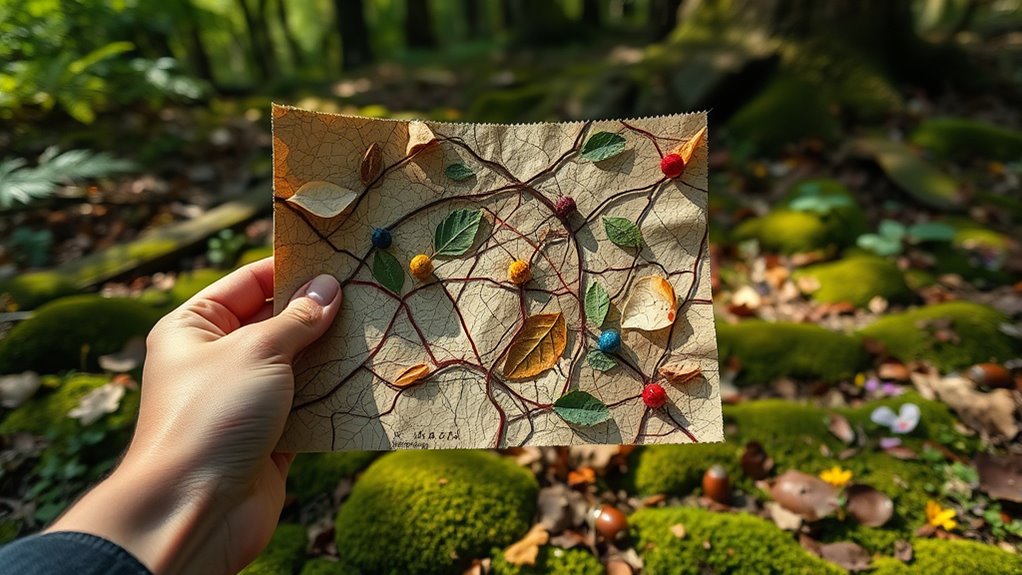
Creating and interpreting natural maps rely on observing the environment carefully and recognizing key features that serve as landmarks and clues. Large landmarks like mountains and lakes help you orient yourself and establish your location. Weather patterns, such as wind direction and precipitation, provide additional clues about your surroundings. Animal migration routes reveal seasonal changes and help refine your navigation. Noticing fetal movements can also offer insights into your environment and health, especially during pregnancy. Variations in plant growth, like denser trees on the south in the Northern Hemisphere, indicate sunlight exposure and soil conditions. Topographic features, including ridges and valleys, assist in visualizing terrain. To interpret natural maps, use shadows at midday for direction, observe plant density, and identify water sources like willows and alders. Recognizing environmental cues and understanding the importance of local resources and tools enhances your ability to create accurate mental or physical maps to guide your movement.
Practical Tips for Sustainable Foraging in Navigation
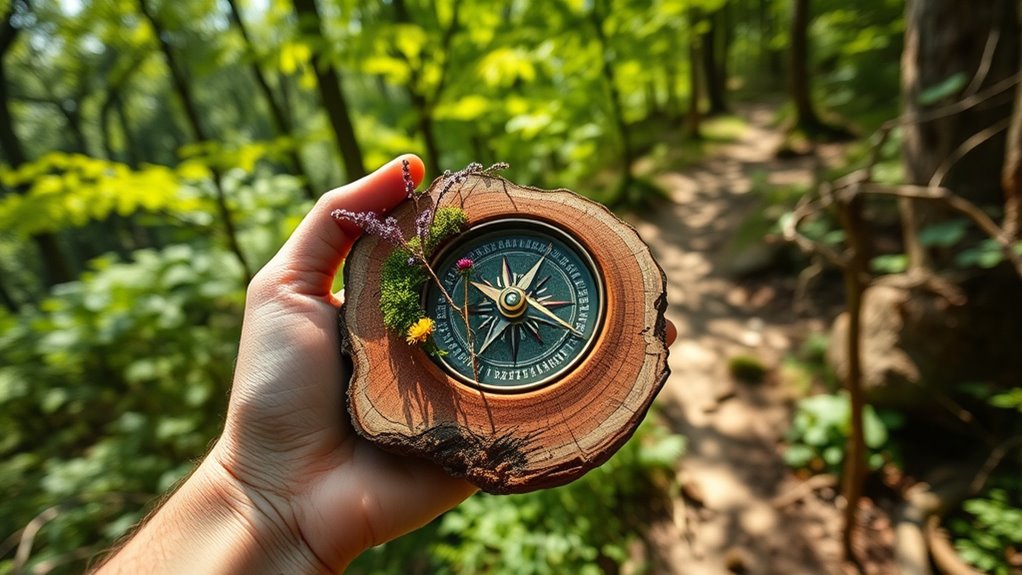
Practicing sustainable foraging enhances your navigation skills while protecting the environment, guaranteeing resources remain available for future use.
Focus on environmental awareness by recognizing landmarks and natural patterns, which help in orienting yourself.
Keep impact minimal by avoiding new trails and staying on marked paths to preserve ecosystems.
Foraging with small groups reduces disturbance and makes navigation easier through less crowded routes.
Use natural features like the sun, prominent landmarks, and geographical formations to guide your way.
Equip yourself with essential tools such as a compass, navigation apps, or star charts for night navigation.
Always monitor weather conditions and carry safety gear.
Plan routes ahead, work with a buddy, and follow Leave No Trace principles to ensure responsible, sustainable navigation that benefits both you and the environment.
Being aware of your symptoms of breast cancer can also be crucial for health.
Additionally, understanding environmental impact factors can help you choose sustainable foraging practices that minimize damage to ecosystems.
To further improve your skills, consider studying natural navigation techniques that utilize environmental cues for more accurate orientation.
Engaging with educational resources on foraging can deepen your understanding of sustainable practices and environmental stewardship.
A good way to expand your knowledge is by exploring foraging workshops and courses, which often include sustainable practices and environmental considerations.
Frequently Asked Questions
Can Foraged Materials Be Used to Create Temporary Directional Signs?
Yes, you can definitely use foraged materials to create temporary directional signs. You gather natural items like branches, leaves, or bark and shape or write on them with charcoal or natural dyes.
You’ll want to make sure your signs are large, clear, and use contrasting colors for visibility. Secure them with twine or rocks, and place them where they’re easily seen.
This eco-friendly approach works great for guiding people in outdoor settings.
How Do Seasonal Changes Affect the Reliability of Natural Navigation Indicators?
Seasonal changes can make natural navigation indicators less reliable. You might find that constellations shift, moon phases change, and weather patterns vary, affecting celestial cues.
Vegetation cycles and animal behaviors also fluctuate, which can mislead your sense of direction. Additionally, weather conditions like snowmelt, wildfires, or cloud cover can obscure landmarks and natural markers, making it harder for you to depend on these cues for accurate navigation year-round.
Are There Specific Foraged Plants That Help Mark Trails Effectively?
When considering specific foraged plants to mark trails, you’ll want to look for those with vivid colors, sturdy stems, and distinctive shapes. Bright flowers or leaves, like red berries or yellow foliage, catch your eye easily.
You can tie branches or arrange leaves to form arrows or signals. These plants stand out against the natural environment, making your trail markers visible, durable, and effective for guiding others safely through the wilderness.
How Can I Combine Multiple Natural Cues for Better Navigation Accuracy?
To combine multiple natural cues for better navigation, you should assess each cue’s reliability and use feedback to adjust their weights.
Focus on visual landmarks and body-based cues, like self-motion signals, which complement each other.
Trust cues that are clearer and more dependable in the current environment, and adapt your reliance based on changing conditions.
This approach helps you navigate more accurately by integrating cues most effectively.
What Precautions Should I Take When Using Natural Materials for Trail Marking?
Think of trail marking as planting breadcrumbs in a forest of uncertainty. You should choose natural materials that won’t harm the environment and guarantee they’re visible yet unobtrusive.
Place markers securely on landmarks, maintain consistency, and respect wildlife.
Always remove or let materials decompose afterward, following local rules.
Conclusion
By blending bold landmarks, celestial cues, and clever clues from nature, you can confidently chart your course using foraged materials. Embrace the earth’s endless evidence, enhance your expertise, and enjoy exploring sustainably. Remember, resourcefulness and respect for nature turn simple sights and signals into a secure, satisfying way to navigate. Trust your instincts, stay savvy, and let the land’s natural language lead you home safely and skillfully.



